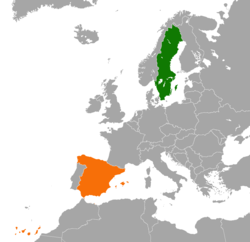Spain–Sweden relations
 | |
Spain |
Sweden |
|---|---|
Spain–Sweden relations are the bilateral and diplomatic relations between these two countries. Sweden has an embassy in Madrid,[1] a consulate general in Barcelona[2] and honorary consulates in Bilbao, Cartagena, Gijón, Granada, Jerez de la Frontera, La Coruña, Las Palmas de Gran Canaria, Málaga, Palma de Mallorca, Sevilla, Torrevieja, and Valencia.[3] Spain has an embassy in Stockholm, as well as an Economic and Social Department and another Tourism Department in the same city, and two honorary consulates in Malmö, Helsingborg and Gothenburg.[4] Relations between Spain and Sweden are mainly defined by their membership in the European Union and the Schengen Area.
Historical relations[]
Swedish interest in Spain comes from afar, especially, due to the fact that the Visigoths, originating from the Goths from the current Swedish region of Götaland, were strongly linked to the social and political transformation of Hispania, the Visigothic Kingdom, creating, what could be, the oldest state in Europe.[5] Already for the year 840 the Vikings arrived in Galician coasts, and then in Andalusian, in search of fortune and good business. In the sixteenth and seventeenth centuries, Sweden had a keen interest in getting salt for food preservation. Some consuls of Sweden in Cádiz had this business as their absolute priority. In 1651 a free trade agreement was signed between the Spanish Empire and the Swedish Empire. In those years, trade in Spain was basically limited to the sale of salt, wine and other foods, compared to wood, iron and copper from Sweden.[6]
Historically, relations have not been very close due to the opposition between Nordic and Protestant peoples against southern and Catholic peoples, also exalted by the confrontation in the religious wars of 17th century. The Civil War (1936-1939) generated a great debate at national level in Sweden about the attitude that the government should take, however, it was decided to maintain neutrality, which did not prevent more 500 Swedish volunteers will travel to Spain to be part of the International Brigades.[7] The years of 1978 and 1979 meant the full normalization of political relations between Spain and Sweden, leaving any reluctance at the level of political parties in relation to the Spanish political process.[8]
Bilateral relations[]

The most important events at the bilateral level were visits to Madrid by former Foreign Affairs Minister Karin Soder and Prime Minister Ullsten, the first time in the history of the two countries that a Foreign Minister and a Swedish Prime Minister were traveling officially to Spain. The results can be described as profitable due to the multiplier effect obtained in the other Scandinavian countries. Fruit of all this was the invitation of the Swedish monarchs to the Kings of Spain to officially visit this country in 1979.[8]
Spain and Sweden maintain a dialogue on the challenges facing the EU. The development of the European digital single market and other free trade agreements between the EU and countries such as the US are common interests between both countries.[6]
At present, Sweden and Spain have excellent bilateral relations. These are characterized by cooperation within the EU and an important trade exchange. Spain is the main tourist destination of the Swedes.[9] With regard to youth mobility, education and culture, Sweden and Spain enjoy active academic relationships.[10]
In 2021, the Swedish royal family received with all the solemnity Spanish Kings Felipe and Letizia on their historic state visit to the Scandinavian country, the first in 42 years, in which both monarchies see an "excellent opportunity" to take a leap in bilateral relations at all levels.[11]
Economic relations[]
In the 21st century, trade has more to do with high-tech products and innovation and sectors such as the environment, telecommunications and information technology. Also in the fashion sector, there is great competition between H&M and Zara in this sector worldwide.[6]
The economic component of bilateral relations has been reinforced since Sweden's accession to the EU on January 1 of 1995 and has been an essential element of bilateral relations, due, above all, to the significant Swedish investments in Spain, both business and residential, as well as the large influx of tourists, consolidated for decades.[12]

Embassies[]
The Embassy of Spain is located in Stockholm, Sweden. The Embassy of Sweden is located in Madrid, Spain.
See also[]
References[]
- ^ "Spanien, Madrid".
- ^ http://www.swedenabroad.com/es-ES/Embassies/Madrid/Contacto/Embajada-y-Consulados/#Barcelona Consulado general de Suecia en España
- ^ http://www.swedenabroad.com/es-ES/Embassies/Madrid/Contacto/Embajada-y-Consulados/#Barcelona Swedish consulates in Spain
- ^ [1]
- ^ "La historia de los godos, la tribu que vino del norte".
- ^ a b c http://www.swedenabroad.com/es-ES/Embassies/Madrid/Comercio/El-comercio-con-Suecia/. Missing or empty
|title=(help) - ^ El papel de Suecia en la guerra civil española (1936-1939), Camacho Padilla, Fernando & Asunción Criado, Ana
- ^ a b http://elpais.com/diario/1979/10/14/internacional/308703603_850215.html Actualidad política de Suecia y de sus relaciones con España, El País, 14 de abril de 1979
- ^ https://www.regeringen.se/sveriges-regering/utrikesdepartementet/sveriges-diplomatiska-forbindelser/europa-och-centralasien/spanien/
- ^ https://svenskspanska.se/?lang=en
- ^ "Suecia da su bienvenida más solemne a los reyes de España en su histórica visita". Agencia EFE. Retrieved 24 November 2021.
- ^ http://www.exteriores.gob.es/Documents/FichasPais/suecia_FICHA%20PAIS.pdf Office of Diplomatic Information
- Spain–Sweden relations
- Bilateral relations of Spain
- Bilateral relations of Sweden

